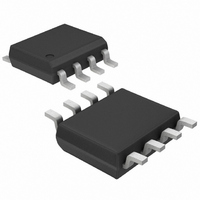DS1077Z-100+ Maxim Integrated Products, DS1077Z-100+ Datasheet - Page 8

DS1077Z-100+
Manufacturer Part Number
DS1077Z-100+
Description
IC ECONOSCIL 2WIRE 100MHZ 8SOIC
Manufacturer
Maxim Integrated Products
Series
EconOscillator™r
Type
Oscillator, Fixed Frequency, Dualr
Datasheet
1.DS1077Z-125TR.pdf
(21 pages)
Specifications of DS1077Z-100+
Frequency
100MHz
Voltage - Supply
4.75 V ~ 5.25 V
Current - Supply
50mA
Operating Temperature
0°C ~ 70°C
Package / Case
8-SOIC (3.9mm Width)
Lead Free Status / RoHS Status
Lead free / RoHS Compliant
Count
-
Lead Free Status / Rohs Status
Details
DS1077
2-WIRE SERIAL DATA BUS
The DS1077 supports a bidirectional 2-wire bus and data transmission protocol. A device that sends data
onto the bus is defined as a transmitter, and a device receiving data as a receiver. The device that controls
the message is called a “master.” The devices that are controlled by the master are “slaves.” The bus must
be controlled by a master device that generates the serial clock (SCL), controls the bus access, and
generates the START and STOP conditions. The DS1077 operates as a slave on the 2-wire bus.
Connections to the bus are made via the open-drain I/O lines, SDA and SCL. A pull-up resistor (5kW) is
connected to SDA.
The following bus protocol has been defined (See Figure 2):
§ Data transfer may be initiated only when the bus is not busy.
§ During data transfer, the data line must remain stable whenever the clock line is HIGH. Changes
in the data line while the clock line is high will be interpreted as control signals.
Accordingly, the following bus conditions have been defined:
Bus not busy: Both data and clock lines remain HIGH.
Start data transfer: A change in the state of the data line from HIGH to LOW while the clock is HIGH
defines a START condition.
Stop data transfer: A change in the state of the data line from LOW to HIGH while the clock line is
HIGH defines the STOP condition.
Data valid: The state of the data line represents valid data when, after a START condition, the data line is
stable for the duration of the HIGH period of the clock signal. The data on the line must be changed
during the LOW period of the clock signal. There is one clock pulse per bit of data.
Each data transfer is initiated with a START condition and terminated with a STOP condition. The
number of data bytes transferred between START and STOP conditions is not limited, and is determined
by the master device. The information is transferred byte-wise and each receiver acknowledges with a
ninth bit.
Within the bus specifications a regular mode (100kHz clock rate) and a fast mode (400kHz clock rate) are
defined. The DS1077 works in both modes.
Acknowledge: Each receiving device, when addressed, is obliged to generate an acknowledge after the
byte has been received. The master device must generate an extra clock pulse, which is associated with
this acknowledge bit.
A device that acknowledges must pull down the SDA line during the acknowledge clock pulse in such a
way that the SDA line is stable LOW during the HIGH period of the acknowledge-related clock pulse. Of
course, setup and hold times must be taken into account. When the DS1077 EEPROM is being written to,
it will not be able to perform additional responses. In this case, the slave DS1077 will send a not-
acknowledge to any data transfer request made by the master. It will resume normal operation when the
EEPROM operation is complete.
A master must signal an end-of-data to the slave by not generating an acknowledge bit on the last byte
that has been clocked out of the slave. In this case, the slave must leave the data line HIGH to enable the
master to generate the STOP condition.
8 of 21












